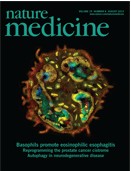2013年8月12日 讯 /生物谷BIOON/ –近日,来自多伦多大学及麻省总医院的研究者通过研究发现,心脏疾病患者动脉内壁致死性斑块的生长或许并不像研究者想象的那样,研究结果或许可以帮助科学家开发治疗动脉粥样硬化的新型靶向性疗法,相关研究成果刊登于国际杂志Nature Medicine上。
在文中研究者发现,诱发动脉粥样硬化的巨噬细胞可以在斑块内部复制,而且这种生长并不依赖于单核细胞,研究者Clint Robbins说道,当前主要认为炎性的巨噬细胞主要来自于单核细胞前体的聚集,但是我们的研究却发现,巨噬细胞的积累同样取决于它们在板块内部的增殖情况。
这项研究对临床的治疗影响是较大的,许多制药公司或许开发阻断白细胞进入斑块的疗法来间接治疗疾病,如果通过局部细胞分裂巨噬细胞可以达到自持的话,那么这种阻断其聚集的方法或许并不是最好的疗法。研究者Filip Swirski表示,这项研究有可能会引发对当前疗法的一些重新评估,人们往往认为通过靶向抑制单核细胞的涌入来治疗动脉粥样硬化,但是也需要考虑巨噬细胞的聚集,尤其是在已经确定病情的患者机体内。
这项研究或许可以更好地对循环的单核细胞进行靶向作用,当然也可以通过其它的免疫反应来有效控制单核细胞。当前的研究可以帮助改善治疗动脉粥样硬化的标准疗法:他汀类药物疗法,该疗法可以通过降低血脂来控制斑块的发展速度,具有抗炎性效果,研究者目前正在研究观察是否他汀类药物可以有效限制斑块内部的巨噬细胞的扩散。
研究者Robbins表示,对巨噬细胞增殖进行靶向作用可以降低动脉粥样硬化病人的炎性表现,研究者前期只是用小鼠进行试验,后期在人体中进行了大量试验,并且发现了人类颈动脉内壁斑块上发现了巨噬细胞生长的情况,下一步研究者将在动脉粥样硬化的不同发病阶段对比巨噬细胞的增殖和单核细胞的聚集的情况,并且观察是否所有的巨噬细胞而不是一部分都在复制,这将对于深入研究动脉粥样硬化的疾病病程以及开发新型靶向性疗法提供思路和希望。(生物谷Bioon.com)

doi:10.1038/nm.3258
PMC:
PMID:
Local proliferation dominates lesional macrophage accumulation in atherosclerosis
Clinton S Robbins,1, 2, 3, 4, 9 Ingo Hilgendorf,1, 9 Georg F Weber,1 Igor Theurl,1 Yoshiko Iwamoto,1 Jose-Luiz Figueiredo,1, 5 Rostic Gorbatov,1 Galina K Sukhova,5 Louisa M S Gerhardt,1 David Smyth,2 Caleb C J Zavitz,2 Eric A Shikatani,2, 3 Michael Parsons,6 Nico van Rooijen,7 Herbert Y Lin,1 Mansoor Husain,2, 3 Peter Libby,5 Matthias Nahrendorf,1 Ralph Weissleder1, 8 & Filip K Swirski1
During the inflammatory response that drives atherogenesis, macrophages accumulate progressively in the expanding arterial wall1, 2. The observation that circulating monocytes give rise to lesional macrophages3, 4, 5, 6, 7, 8, 9 has reinforced the concept that monocyte infiltration dictates macrophage buildup. Recent work has indicated, however, that macrophage accumulation does not depend on monocyte recruitment in some inflammatory contexts10. We therefore revisited the mechanism underlying macrophage accumulation in atherosclerosis. In murine atherosclerotic lesions, we found that macrophages turn over rapidly, after 4 weeks. Replenishment of macrophages in these experimental atheromata depends predominantly on local macrophage proliferation rather than monocyte influx. The microenvironment orchestrates macrophage proliferation through the involvement of scavenger receptor A (SR-A). Our study reveals macrophage proliferation as a key event in atherosclerosis and identifies macrophage self-renewal as a therapeutic target for cardiovascular disease.

